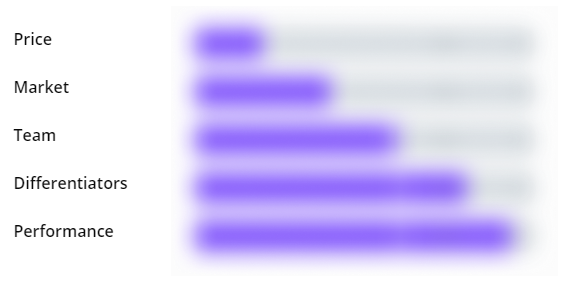Overview
$8,990,050 - Total
Rolling Commitments ($USD)
06/29/2021
$62,500
3,790
2012
Financial & Insurance Products & Services
Fintech
B2B
High
Low
Summary Profit and Loss Statement
| Most Recent Year | Prior Year | |
|---|---|---|
|
Revenue |
$4,243,105 |
$2,373,669 |
|
COGS |
$214,120 |
$108,827 |
|
Tax |
$0 |
$0 |
| ||
| ||
|
Net Income |
$-1,122,515 |
$-957,073 |
Summary Balance Sheet
| Most Recent Year | Prior Year | |
|---|---|---|
|
Cash |
$1,643,140 |
$1,671,204 |
|
Accounts Receivable |
$0 |
$0 |
|
Total Assets |
$1,660,582 |
$1,732,977 |
|
Short-Term Debt |
$79,896 |
$152,067 |
|
Long-Term Debt |
$0 |
$0 |
|
Total Liabilities |
$79,896 |
$152,067 |
Raise History
| Offering Name | Close Date | Platform | Valuation/Cap | Total Raised | Security Type | Status | Reg Type |
|---|---|---|---|---|---|---|---|
| Wefunder | 12/21/2023 | Wefunder | $175,000,000 | $4,034,287 | SAFE | Funded | RegD 506(c) |
| Wefunder | 11/01/2022 | Honeycomb | $290,000,000 | $2,760,843 | Equity - Preferred | Funded | RegCF / RegD 506(c) |
| Wefunder | 06/03/2021 | Honeycomb | $160,000,000 | $8,990,050 | Equity - Preferred | Funded | RegCF / RegD 506(c) |
Price per Share History
Note: Share prices shown in earlier rounds may not be indicative of any stock splits.
Valuation History
Revenue History
Note: Revenue data points reflect the latest of either the most recent fiscal year's financials, or updated revenues directly from the founder, at each raise's close date.
Employee History
Upgrade to gain access
-
$25 /month
billed annually - Free portfolio tracking, data-driven ratings, AI analysis and reports
- Plan Includes:
- Everything in Free, plus
- Company specific
KingsCrowd ratings and analyst reports
- Deal explorer and side-by-side comparison
- Startup exit and failure tracking
- Startup market filters and historical industry data
- Advanced company search ( with ratings)
- Get Edge Annual
Edge
Synopsis
One of the biggest changes in investing over the past decade has been the ability for companies to raise capital through crowdfunding due to legislation signed in the early 2010s, followed by additional legislation over the years. Prior to this, companies were stuck relying on accredited investors for outside equity and debt funding. The growth of the space has been impressive, and the opportunities it presents to average investors cannot be overstated.
When crowdfunding began, companies could only raise $1.07 million each year through Regulation Crowdfunding raises. As of this year, that figure has been increased to $5 million. Under Regulation A+, the initial yearly limit was $50 million, but now, it stands at $75 million. These increases make it more attractive for the startups in question to go this route as opposed to more restrictive funding methods, such as finding venture capitalists or going public.
As with the creation of any new industry, early movers take advantage. One of these is Wefunder. Through its website, Wefunder hosts crowd raises and allows investors to participate in them by showing the stories and terms of the deal associated with these companies. The business model employed by Wefunder is fairly straightforward. The company merely charges a percent of the assets raised to its client companies. The fee for those falling under Regulation Crowdfunding stands at 7.5%. For Regulation A+, the company charges a flat fee of $375,000. All amounts charged apply only to the companies that raise their minimum targets. It is also worth mentioning that in November 2021, the company will be expanding and launching in Europe.
Wefunder’s current raise on Honeycomb has been rated a Deal to Watch by the KingsCrowd investment team.
Price
Wefunder is offering Series F Preferred stock at a pre-money valuation of $160 million. Although Wefunder is a major market leader, this price is undeniably high. Therefore, the price score is Wefunder’s lowest across all five metrics.
Market
According to one source, the general crowdfunding market is fairly average. In 2018, the space was worth $10.2 billion. By 2025, this is expected to grow to $28.8 billion, implying a robust growth rate of 16% per annum. A second source suggested that in 2019 the market was worth $12.39 billion. Its expectation is for it to grow at a rate of 11.2% per annum through 2026. If this comes to fruition, the industry would be worth $23.2 billion by the end of that forecast period. The smaller niche for investing via crowdfunding was estimated to be worth $6.25 billion this year. With an annualized growth rate expected of it of around 8.5%, it should expand to $8.53 billion by 2025. From all the data shown, this market looks to be growing rapidly no matter what, as it continued to expand throughout the COVID-19 pandemic. As a result, Wefunder’s market rating is very strong.
Team
Another area in which Wefunder excels is its team. Nick Tommarello is the company’s co-founder and CEO. Prior to starting the company, Tommarello dabbled in the creation of several different apps and websites. Before that, he was the president and founder at Urban Interactive incorporated, a company focused on augmented reality tourism adventures. Naturally, all of this demonstrates an affinity toward entrepreneurship, leadership, creativity, and flexibility.
The other key individual at Wefunder is Greg Belote, the company’s other co-founder and CTO. Before starting Wefunder, Belote founded and ran his own consulting firm. Prior to that, he co-founded a company called Gameroom.io. He also co-founded a firm called TutorialTab, which created hands-on interactive tutorials for companies to place on their websites. Immediately prior to that, Belote worked as a software engineer for TripAdvisor. All of this demonstrates leadership experience as well as technical skills that would be relevant for a company like Wefunder.
Together, Tommmarello and Belote bring a strong combination of leadership skills, entrepreneurial know-how, and technical expertise. As such, Wefunder’s team score is high.
Differentiators
In most respects, there is not a lot differentiating Wefunder from the competition. It generates revenue in approximately similar ways and engages in the same core activities as other crowdfunding platforms. What is special about Wefunder is just how large it is. In the fourth quarter of its 2020 fiscal year, the company pegged its market share at 42%. This compares to 27% for StartEngine, its largest competitor, and Republic at 13%. That significant market size alone is a major point of differentiation. It is worth mentioning that these numbers are based on management’s own estimate. A separate source indicates that the size disparity between them is smaller. It implied that Wefunder carried a market share in 2020 of 33.7%. This compares to 32.6% for StartEngine and Republic at 17.9%. Irrespective of what the number is, being the market leader is a massive point of differentiation. Because of this, Wefunder’s differentiators score is above average.
Performance
By many accounts, the financial performance of Wefunder is impressive. In 2019, the company generated revenue of $2.37 million. This surged to $4.24 million in 2020. Though not listed in its financials, the company has said that its annual run rate revenue this year is around $8 million. Revenue has increased because the company’s deal volume has increased overtime. Back in 2019, for instance, the volume of deals completed on the site grew to $41.45 million. By 2020, this more than doubled to $87 million. By December 2020, annualized deal volume had hit $205 million.
Management’s goal for 2021 is to see deal volume rise to $350 million, with an annualized figure by the end of the year of $600 million. If this comes to fruition, it would result in annualized revenue of $50 million. To achieve this, Wefunder needs to see its average deal size climb to around $500,000, up from $225,000 in 2020. It would also need to see an average of 100 companies raising money on its platform every month. While this is a tall order, it pales in comparison to the $200 million in annual revenue the company is targeting by the year 2024. Even though the industry can be expected to grow over the next few years, such strong growth would likely result in Wefunder’s market share climbing even higher than the 41% that it stands at today.
It is worth mentioning that while revenue growth has been impressive, the company has yet to generate a profit. In 2019, the business generated a loss of $957,073, and this loss grew to $1.12 million in 2020. Operating cash outflows have been nearly identical, totaling $966,244 in 2019 and $1.07 million in 2020.
Due to all of the traction it has received already, Wefunder’s projections for itself are probably not unrealistic. In light of the company’s achievements so far, the company scores very highly in the performance metric.
Risks
Our system rated the risk profile of Wefunder in a favorable light. The platform has a fully built product with verified product-market fit. It is generating revenue, and the founding team is experienced. The main risk for Wefunder comes from the potential for market regulations to slow or hinder crowdfunding’s growth.
Bearish Outlook
There are two main risks for investors to consider with Wefunder. The first of these is the price. Wefunder’s valuation of $160 million is nearly 38 times higher than its revenue from 2020. It creates a higher chance of a painful downturn for investors if things don’t go right. Second, the business is still generating sizable net losses and net cash outflows. This can continue for some time, but there is no denying the fact that at some point the business must generate a profit and positive cash flows.
Bullish Outlook
Most of the data that investors have to consider falls on the bullish side of the equation. While Wefunder is generating net losses and net cash outflows, revenue is strong and growing rapidly. The company is in a growing market that is likely to continue growing in the years to come. It is the market leader, which is incredibly valuable, and its team looks quite solid.
Executive Summary
Putting everything together, Wefunder is a well-established name in the crowdfunding space. Its strong revenue growth is appealing. It has the industry’s leading market share, and management has done a great job growing it over time. In all, it is easy to see why investors would want to put this on their list of startups to consider. More likely than not, Wefunder will continue to deliver for the foreseeable future. Collectively, these conclusions led our team to rate the business a Deal to Watch.
For questions regarding the KingsCrowd staff pick or ratings for this company, please reach out to support@kingscrowd.com.
Analysis written by Daniel Jones.


